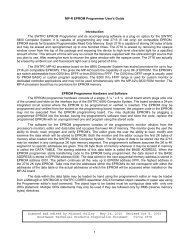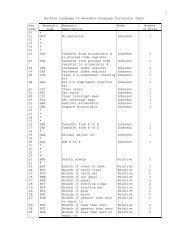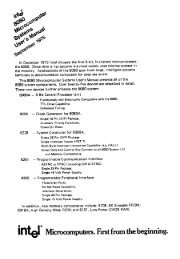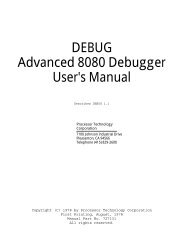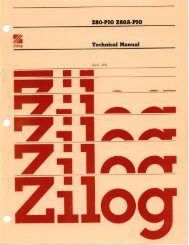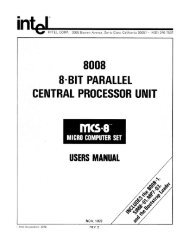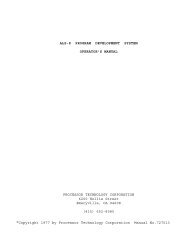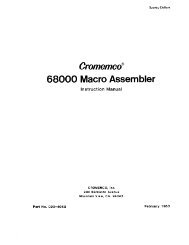The System Manual of SOL-20 - History of Computers
The System Manual of SOL-20 - History of Computers
The System Manual of SOL-20 - History of Computers
You also want an ePaper? Increase the reach of your titles
YUMPU automatically turns print PDFs into web optimized ePapers that Google loves.
PROCESSOR TECHNOLOGY CORPORATION<br />
Sol THEORY OF OPERATION<br />
SECTION VIII<br />
causes LED3, the LOCAL light, to turn on. A second closure <strong>of</strong> the<br />
LOCAL key toggles this section <strong>of</strong> U15 to the opposite condition.<br />
Note that LOCAL has no affect on keyboard data.<br />
<strong>The</strong> other outputs from U12 are BREAK (pin 12), CONTROL (pin<br />
6) and REPEAT (pin 9). BREAK is inverted in U23 to become !BRK on<br />
pin 4 <strong>of</strong> J1. CONTROL is applied directly to input pin 1 <strong>of</strong> U18 so<br />
that the control character related to the low order bits enters U1<br />
and U2.<br />
REPEAT is applied to pins 10 and 11 <strong>of</strong> NAND gate U27 and pin<br />
13 <strong>of</strong> NAND gate U16. <strong>The</strong> input to U27 is gated with UPPER_CASE to<br />
generate !RST at pin 13 <strong>of</strong> J1. This means, <strong>of</strong> course, that REPEAT and<br />
UPPER_CASE must be depressed at the same time to generate !RST.<br />
On pin 13 <strong>of</strong> U16, REPEAT enables that gate so that U16 transmits<br />
the output on pin 9 <strong>of</strong> U9. U9 is connected as a two-stage shift<br />
register whose input (pin 2) is ground. It is clocked by clock_128<br />
from U5.<br />
U9 is initially set with output pins 5 and 9 high during the<br />
third count cycle by PKD_minus_1. This is also the time when U12<br />
outputs data. If the key is released, U9 clears to a low on pin 9<br />
five count cycles following KEY. If the key is held down, U9 cannot<br />
shift since PKD minus I remains on preset input pins 4 and 10.<br />
When REPEAT exists at pin 13 <strong>of</strong> U16, pin 11 <strong>of</strong> U16 is low to<br />
inhibit U25 and U27 at pin 13. This prevents further KEY signals and<br />
disables the n-key rollover circuitry. <strong>The</strong> low on pin 11 <strong>of</strong> U16 is<br />
also inverted by open collector inverter U24 to enable the repeat<br />
oscillator (timer U3, R4, R5 and C3). U3 generates a square wave on<br />
pin 3 with a period determined by the RC network.<br />
This clocks the first stage <strong>of</strong> D flip-flop U11, the !STROBE<br />
generator, and U11 produces the previously discussed 6 usec !STROBE.<br />
U11 continues to generate !STROBE at the repeat oscillator rate until<br />
either the REPEAT or character key is released. And with each !STROBE,<br />
<strong>of</strong> course, the data associated with the character key is latched into<br />
U1 and U2.<br />
Eight ASCII-coded data bits are output by U1 and U2 to J1 as<br />
indicated. Seven bits (0-6) are used for ASCII characters, and the<br />
eighth bit (7) is set only for certain control characters that are<br />
recognized by the Sol program. <strong>The</strong>se are used for control functions<br />
such as MODE_SELECT and cursor movement.<br />
<strong>The</strong> remaining circuit, R32 and C14, initializes the keyboard<br />
when power is applied. That is, it resets the output latches and the<br />
SHIFT/SHIFT_LOCK, UPPER_CASE and LOCAL flip-flops. It also inhibits<br />
STROBE at pin 1 <strong>of</strong> NAND gate U10.<br />
VIII-45



